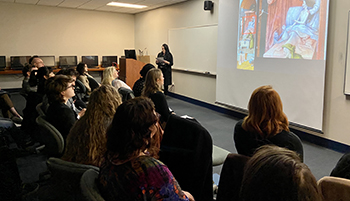Light in the Darkness: The Franciscan Influence on Caravaggio’s the Taking of Christ
Description/Abstract/Artist Statement
The 1602 Taking of Christ by the Italian Baroque painter Caravaggio captures the moment of Judas’s betrayal of Christ and its result, Christ’s arrest by the Roman soldiers. The canvas was only recently rediscovered in 1990 and it has surprisingly received very little in-depth scholarship. Art historians have centered primarily on the story of its rediscovery or on the identities of the figures in the painting and in particular the frightened figure behind Christ quickly exiting the scene. Scholarship has thus remained superficial and piecemeal. In 2016, Stefano Zuffi and Philip Cottrell briefly mentioned the Franciscan influence in Caravaggio’s Taking of Christ, both centering however only on the accepting and submissive countenance of Christ. The consideration of the popularity and influence of the founder of the Franciscan order, Saint Francis of Assisi, and the Franciscans before and during Caravaggio’s lifetime and its influence on the artist and the overall canvas has therefore been largely overlooked. This paper argues that the Franciscan order and Franciscan spirituality was a major influence in the Taking of Christ, beyond just that of Christ’s gesture and expression. By examining the unconventional pictorial devices Caravaggio utilized in his canvas against the backdrop of Franciscan spirituality, the canvas’s meaning and message of faith, as exemplified by Saint Francis of Assisi and the Franciscans, becomes powerfully clear.
Faculty Advisor/Mentor
Anne Muraoka
Presentation Type
Oral Presentation
Disciplines
Ancient, Medieval, Renaissance and Baroque Art and Architecture
Session Title
College of Arts & Letters 1
Location
Learning Commons @ Perry Library Room 1306
Start Date
2-8-2020 9:00 AM
End Date
2-8-2020 10:00 AM
Light in the Darkness: The Franciscan Influence on Caravaggio’s the Taking of Christ
Learning Commons @ Perry Library Room 1306
The 1602 Taking of Christ by the Italian Baroque painter Caravaggio captures the moment of Judas’s betrayal of Christ and its result, Christ’s arrest by the Roman soldiers. The canvas was only recently rediscovered in 1990 and it has surprisingly received very little in-depth scholarship. Art historians have centered primarily on the story of its rediscovery or on the identities of the figures in the painting and in particular the frightened figure behind Christ quickly exiting the scene. Scholarship has thus remained superficial and piecemeal. In 2016, Stefano Zuffi and Philip Cottrell briefly mentioned the Franciscan influence in Caravaggio’s Taking of Christ, both centering however only on the accepting and submissive countenance of Christ. The consideration of the popularity and influence of the founder of the Franciscan order, Saint Francis of Assisi, and the Franciscans before and during Caravaggio’s lifetime and its influence on the artist and the overall canvas has therefore been largely overlooked. This paper argues that the Franciscan order and Franciscan spirituality was a major influence in the Taking of Christ, beyond just that of Christ’s gesture and expression. By examining the unconventional pictorial devices Caravaggio utilized in his canvas against the backdrop of Franciscan spirituality, the canvas’s meaning and message of faith, as exemplified by Saint Francis of Assisi and the Franciscans, becomes powerfully clear.

